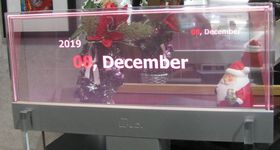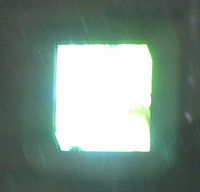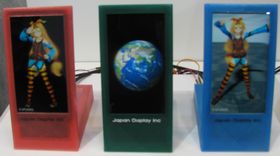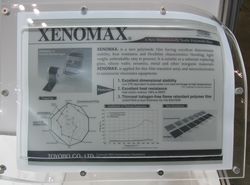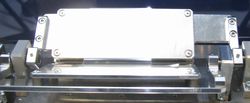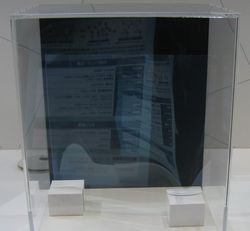 STELLA NEWS SITE is managed by Stella Corporation Inc. |
9th FINETECH JAPAN (December 4-6, 2019) |
||||||||||||||||||
December 4-6, 29th FINETECH JAPAN was held in Makuhari Messe. Main topics in these exhibitions are picked up. Transparent TFT-LCD is obtained by FS driving of RGB-LED backlights
If switch is turn on, liquid crystal becomes to be transparent, as a result, light from back-light is extracted ahead by light scattering. RGB-LED backlights are turn on speedily and sequentially by the field sequential driving method. For this reason, micro color filter and polarizer are not necessary. Its transmittance is 87 %, display colors is 4096, contrast ratio is 30:1, and brightness is 150cd/m2 (4-inch) or 300 cd/m2 (12.3-inch). And also, the company disclosed a new 3D display module gField Light Displayh. It's a glass-free 3D panel using the parallax barrier method. However, its concept is different from the existing products. Concretely, in the existing panel, same 3D image is displayed in all observing points by fixing some observing points. On the other hand, in this Field Light Display, subtly different 3D image is displayed each other observing point by observing point-free concept. In short, natural 3D image can be displayed compared to the conventional panel.
Furthermore, the company exhibited a 1.6-inch micro-LED display (300~300 pixel), too. Display image from this panel could not be proficiently shot by the digital camera because of high brightness (3000cd/m2). However, mounting method of RGB-LEDs on LTPS substrate and relationship with glo (USA) were not disclosed at all. Main candidate of mounting method of RGB-LED sub-pixels was introduced By contrast, there was an interesting announcement about manufacturing process of micro-LED display in the booth of Joyo Engineering, which was an FPD system maker. In the booth, U.K.TECHNOLOGY (Taiwan) introduced a mounting method of RGB-LED pixels on TFT substrate for micro-LED display. Concretely, first of all, a panel maker prepares R, G, B-LED wafers respectively. Unnecessary area is eliminated by the laser direct etching treatment based on pixel design. In short, in case of Red piece, Green and blue sub-pixel areas are cut. The above process is repeated by 3 times (R, G, and B). This piece size is 30 ~ 30 o in the present moment. The next, each LED sub-pixel in LED piece is transferred to PDMS (Polydimethylsiloxane) stamp, and then, it is mounted on the TFT substrate by the intermediary of adhesive layer. This process is repeated by R, G, and B respectively, and these processes are repeated by a few dozen times in accordance with display size. The company pointed that this method is only realistic mass-production process in the present moment.
With respect to material for flexible device, Nagase and Toyobo introduced a low thermal expansion polyimide filmgZENOMAXh in each booth. It's originally developed by Zenomax Japan, which is a joint corporation of both companies. It has not only high thermal resistance (500 ), but also, extremely low linear expansion coefficient (0 - 72 ppm/K). It is almost same as that of glass and silicon wafer. Furthermore, surface flatness is excellent same as Ra0.5nm. In the booth of both companies, as picture 4, an electrophoretic type e-paper display with this film substrate was exhibited. And also, Mini-LED display with this film was disclosed in the booth of Toyobo, too. It seemed to be adopted for substrate of e-paper display in the mass-production. Cover film with rigid and bendable properties appeared
Al2O3 gas barrier film is deposited by a new ALD system
|
||||||||||||||||||
| REMARK STELLA NEWS SITE is a free news site of FPD and PCB by Stella Corporation Inc.(This company does not release these FPD and PCB related products.) |
| Stella will run a booth at 37th ELECTROTEST JAPAN which will be held in Tokyo Big Sight on Jan 15 (Wed) - 17 (Fri), 2020. Our booth is W3-56. |

